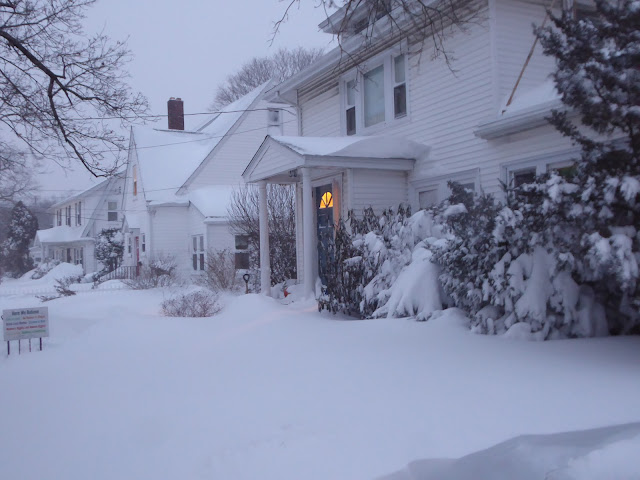

Saturday's blizzard left frozen waves having troughs with barely a foot of snow while peaks approached
three feet–and spots bizarrely bare around many trees. That night I dusted off the snowshoes I'd
purchased after after the snowy winter of 2015. I sank halfway to my knees with each step and promptly
fell. With my snowshoes floating a foot higher than my hands as I tried to rise, I recalled that the
snowshoes had come with ski poles! Today, though, in snow consolidated by the two intervening days,
the snowshoes proved their worth.
Curious to find what animals had been about, I went track hunting. My first surprise was the garage
where local stray cats often shelter in cold weather: no sign of any coming and going. Were the cats
trapped, or gone from the neighborhood, or was the snow simply too deep for them? If the last, where
were they sheltering?
In the backyard and the scrubby woods behind I expected to find the usual bird and squirrel tracks, and
hoped for coyote. (It's been years since a coyote regularly visited us in hopes, I suppose, that the egg
shells in our compost signaled the presence of actual eggs.) There were no coyote tracks, and barely
even any squirrel tracks. Only a few short trackways showed squirrel travel mostly between very small
trees. Perhaps these trees were too small to feed a squirrel, or perhaps there weren’t branches near
enough for aerial travel between such small trees.
A few places that drew my interest turned out to be irregular marks of snow and ice fallen from trees.
Long shadows.
Then I spotted tracks made by something that bounded rhythmically to make larger impressions about
a foot apart. The back of each impact was marked by a pair of wedge-shaped impressions that
somehow made me think of a Batman silhouette. The front of some of these impacts had a single pair
of small, much-deeper impressions. (The scattering of snow left when the animal leapt back upwards
after each impact showed the direction of travel.) Although some of these trackways.went from tree to
tree, most of the eight or nine I saw either began or ended in the open–several feet away from the
nearest tree.
A bird then, a raptor, even, perhaps sometimes dropping from a low perch, its wingtips making the
“batman” ears on either side.
Was the bird hunting? There were no smaller tracks. Could hidden rodents even be detected beneath
so much snow? The impacts didn’t seem deep enough to reach the ground beneath, and there was
never confusion of the snow showing a struggle. All unsuccessful hunting?
And why so many hops in succession??
For now, the mystery remains.














































































